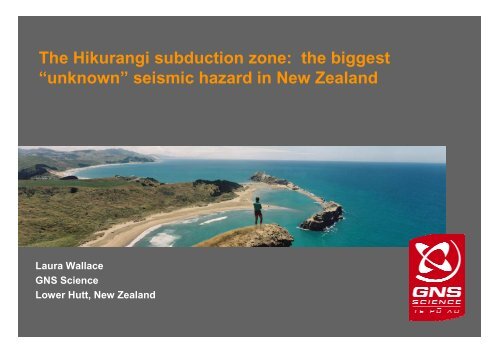The Hikurangi subduction zone - HazardsEducation.org
The Hikurangi subduction zone - HazardsEducation.org
The Hikurangi subduction zone - HazardsEducation.org
- No tags were found...
Create successful ePaper yourself
Turn your PDF publications into a flip-book with our unique Google optimized e-Paper software.
<strong>The</strong> <strong>Hikurangi</strong> <strong>subduction</strong> <strong>zone</strong>: the biggest“unknown” seismic hazard in New ZealandLaura WallaceGNS ScienceLower Hutt, New Zealand
AcknowledgementsJohn BeavanMark StirlingWarwick SmithKate ClarkKelvin BerrymanUrsula CochranNicola LitchfieldMartin ReynersStephen BannisterWilliam PowerPhil BarnesGeoNetand many others…GNS Science
New Zealand’sshaky situationbetween two majortectonic plates…CVR/TVZHavre Havre Trough TroughMarlborough<strong>Hikurangi</strong> <strong>Hikurangi</strong>Plateau PlateauChatham RiseSubduction of the Pacific Plateoccurs beneath the eastern NorthIsland at the <strong>Hikurangi</strong> TroughFiordlandImage from NIWANational Institute of Water and Atmospheric Research LtdGNS Science
<strong>The</strong> <strong>subduction</strong> interface is the FASTESTslipping fault in New Zealand (2-6 cm/yr slip rate)GNS Science
Earthquakes in the North Island (1990-2007)—most of thisseismicity is related to the subducting Pacific PlateImportantly, there have been no historical events on the <strong>subduction</strong> thrust > Mw 7.2GNS Science
Why do we care? Rupture of the <strong>subduction</strong> interface fault cancause large, damaging earthquakes and generate tsunamiGNS Science
How do we unlock the secrets of the <strong>subduction</strong>thrust? A major tool that can be used is GPSContraction of the upperplate between interfaceearthquakesSudden deformation; possible tsunamiGNS Science
Blocks used and fits to data in blockmodel:Interseismic locking (in terms of slip deficit rate)Wallace et al., 2004GNS Science
“Slow slip events” occur on the <strong>subduction</strong> interface beneaththe North Island—they also give insight into <strong>subduction</strong>earthquake potential• <strong>The</strong>se “slow slip events” or “silentearthquakes” are best detectedwith continuous GPS• We have observed up to fifteendistinct slow slip events in fourdifferent parts of the North Island• Worldwide, slow slip events areobserved to occur at the transition<strong>zone</strong> between “coupled” and“creeping” portions of the interface• Slow slip events have also beendocumented at <strong>subduction</strong>margins in Japan, northwest U.Sand western Canada, Mexico, andCosta RicaGNS Science
Operationalcontinuous GPS sites(NZ GeoNet)Since 2002, we haveobserved at least 15distinct slow slipevents at CGPS sitesin the North Islandwww.geonet.<strong>org</strong>.nzGNS Science
Examples of slow slip events(SSEs) at <strong>Hikurangi</strong> margin,2002 to 2008• Panel shows east component of selected stations,as measured each day by cGPS• Traces “detrended” so that the westward intereventmotion is represented by a horizontal line• Up to 13 SSEs, with 7 having displacements of 10mm or more at the ground surface• Short-term (days to weeks); and longer-term (manymonths) SSEsNorthern sitesmillimetresSSESSESSESouthern sitesGNS Science
Slow slipeventsoffshoreGisborneOctober 2002 November 2004 July 2006• Very shallow SSEs(
SSEs in theHawke’sBay regionJune 2006 August 2006 February 2008•Very shallow SSEs (
Slow slip events beneath the southern North IslandRepresentative timeseries from CGPS sitesAffected by SSEs in the southern North IslandCGPS sites in the NorthIsland and northern SouthIslandwww.geonet.<strong>org</strong>.nzGNS Science
Total slip in the Kapiti 2003 and Manawatu 2004/2005 SSEs wasequivalent to a Magnitude 7.3 earthquake, and occurred alongthe edges of the region of strong locking between the platesGNS Science
Kapiti 2008 slow slip event lasted ~15 months, wasequivalent to a Magnitude 7.0 earthquakeWellingtonGNS Science
Slow slip events delineate the <strong>zone</strong> of locking on the<strong>subduction</strong> interfaceFault locking using campaign GPSvelocities averaged over the last~15 yearsGreen contours show total slip onthe interface in slow slip eventssince 2002Wallace and Beavan, in pressGNS Science
<strong>The</strong> BIG problem…NZ has a short historical record, so we knowvery little about the previous earthquakes on the <strong>Hikurangi</strong><strong>subduction</strong> interface• Moderate magnitude (< 7.2)historical interfaceearthquakes occur on theedges of the strongly coupledportion of the interface, or inthe region of weak, shallowinterseismic coupling• If the southern portion of themargin ruptures in events with6-10 m of slip, it could producemagnitude >8-8.5earthquakes. BUT, we haveNO idea if such events occurhere (Wallace et al., 2009)GNS Science
Searching for pre-historic Subduction earthquakes—avery difficult problem in central New ZealandSubsidenceUpliftCommon signatures of <strong>subduction</strong> earthquakes inthe geologic records:Crustal uplift and subsidence, tsunami deposits,liquefaction features, large landslides, offshoresediment mobilisationBig Lagoon, near BlenheimGNS Science
Hawke’s Bay regionUplift & SubsidenceMarine terraces at MahiaMahiaWairoaPakuratahiAhuririCochran etal., 2006Hayward etal., 2006SubductionInterface:Magnitude 8.2?GNS Science
<strong>Hikurangi</strong> <strong>subduction</strong> interface earthquakes can posea serious tsunami hazardWave heights due to a plausible Magnitude 8.5<strong>subduction</strong> interface rupture scenario beneath thelower North IslandPower et al., 2008GNS Science
Improved understanding of the <strong>subduction</strong> fault has had abig impact on the latest NZ National Seismic Hazard modelcourtesy of Mark StirlingGNS Science
Our latest understanding of the <strong>subduction</strong> interfaceearthquake potential has had a major impact on recent lossestimate models for the Wellington regionWellington region losses - 2005 modelWellington region losses - 2010 model100%1200100%1200Percentage90%80%70%60%50%40%30%Subduction <strong>zone</strong>contribution1000800600400Return period (years)Percentage90%80%70%60%50%40%30%Subduction <strong>zone</strong>contribution1000800600400Return period (years)WellWHVOhariuSWair1855PukeShepSub. ZoneWairauOther faultsBackground20%10%20020%10%200Return period0%05 10 15 20Loss (% of value)0%05 10 15 20Loss (% of value)Smith and Harmsen, 2010<strong>The</strong> <strong>subduction</strong> <strong>zone</strong> is now recognized as a major potential threat to future economic lossin the Wellington region. Better understanding of the actual hazard posed by the <strong>subduction</strong>interface is sorely needed.GNS Science
Conclusions• <strong>The</strong> <strong>subduction</strong> interface is the fastest slipping fault in New Zealand (2-6cm/yr), and poses a major seismic and tsunami hazard to the North Island• Interpretation of campaign GPS velocities reveals that the <strong>subduction</strong> thrustbeneath the lower North Island is strongly “locked”; this “locking” is causing abuild-up of stress at the plate boundary and is likely to be reversed in a majorearthquake at sometime in the future.• Continuous GPS data (from GeoNet) has enabled the discovery of slow slipevents on the <strong>subduction</strong> thrust. <strong>The</strong>se events follow the deeper limits oflocking and help to delineate the likely rupture area of future <strong>subduction</strong>interface earthquakes• THE BIG PROBLEM: New Zealand has a very short historical record, so we donot know WHERE, IF, or HOW OFTEN Great <strong>subduction</strong> thrust events (e.g.,Magnitude >8.0) have occurred at the <strong>Hikurangi</strong> <strong>subduction</strong> margin in the past• More complete knowledge of the behaviour of the <strong>Hikurangi</strong> <strong>subduction</strong>interface fault is needed for full understanding of the seismic and tsunamihazard that it poses to the North IslandGNS Science
GNS Science


